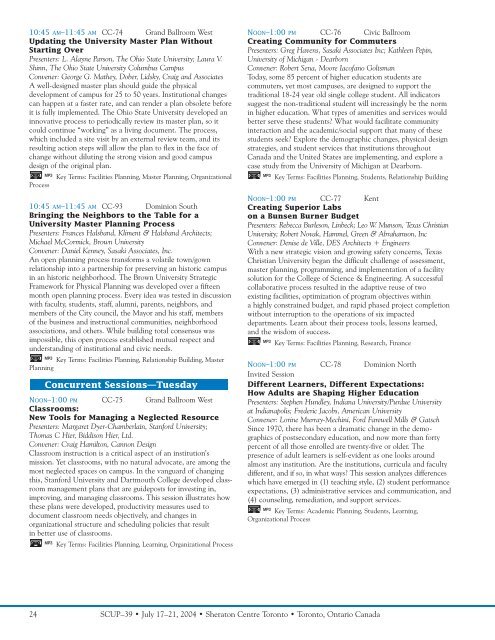Conference Brochure - Society for College and University Planning
Conference Brochure - Society for College and University Planning
Conference Brochure - Society for College and University Planning
- No tags were found...
You also want an ePaper? Increase the reach of your titles
YUMPU automatically turns print PDFs into web optimized ePapers that Google loves.
10:45 AM–11:45 AM CC-74 Gr<strong>and</strong> Ballroom WestUpdating the <strong>University</strong> Master Plan WithoutStarting OverPresenters: L. Alayne Parson, The Ohio State <strong>University</strong>; Laura V.Shinn, The Ohio State <strong>University</strong> Columbus CampusConvener: George G. Mathey, Dober, Lidsky, Craig <strong>and</strong> AssociatesA well-designed master plan should guide the physicaldevelopment of campus <strong>for</strong> 25 to 50 years. Institutional changescan happen at a faster rate, <strong>and</strong> can render a plan obsolete be<strong>for</strong>eit is fully implemented. The Ohio State <strong>University</strong> developed aninnovative process to periodically review its master plan, so itcould continue “working” as a living document. The process,which included a site visit by an external review team, <strong>and</strong> itsresulting action steps will allow the plan to flex in the face ofchange without diluting the strong vision <strong>and</strong> good campusdesign of the original plan.Key Terms: Facilities <strong>Planning</strong>, Master <strong>Planning</strong>, OrganizationalProcess10:45 AM–11:45 AM CC-93 Dominion SouthBringing the Neighbors to the Table <strong>for</strong> a<strong>University</strong> Master <strong>Planning</strong> ProcessPresenters: Frances Halsb<strong>and</strong>, Kliment & Halsb<strong>and</strong> Architects;Michael McCormick, Brown <strong>University</strong>Convener: Daniel Kenney, Sasaki Associates, Inc.An open planning process trans<strong>for</strong>ms a volatile town/gownrelationship into a partnership <strong>for</strong> preserving an historic campusin an historic neighborhood. The Brown <strong>University</strong> StrategicFramework <strong>for</strong> Physical <strong>Planning</strong> was developed over a fifteenmonth open planning process. Every idea was tested in discussionwith faculty, students, staff, alumni, parents, neighbors, <strong>and</strong>members of the City council, the Mayor <strong>and</strong> his staff, membersof the business <strong>and</strong> instructional communities, neighborhoodassociations, <strong>and</strong> others. While building total consensus wasimpossible, this open process established mutual respect <strong>and</strong>underst<strong>and</strong>ing of institutional <strong>and</strong> civic needs.Key Terms: Facilities <strong>Planning</strong>, Relationship Building, Master<strong>Planning</strong>NOON–1:00 PM CC-75 Gr<strong>and</strong> Ballroom WestClassrooms:New Tools <strong>for</strong> Managing a Neglected ResourcePresenters: Margaret Dyer-Chamberlain, Stan<strong>for</strong>d <strong>University</strong>;Thomas C Hier, Biddison Hier, Ltd.Convener: Craig Hamilton, Cannon DesignClassroom instruction is a critical aspect of an institution’smission. Yet classrooms, with no natural advocate, are among themost neglected spaces on campus. In the vanguard of changingthis, Stan<strong>for</strong>d <strong>University</strong> <strong>and</strong> Dartmouth <strong>College</strong> developed classroommanagement plans that are guideposts <strong>for</strong> investing in,improving, <strong>and</strong> managing classrooms. This session illustrates howthese plans were developed, productivity measures used todocument classroom needs objectively, <strong>and</strong> changes inorganizational structure <strong>and</strong> scheduling policies that resultin better use of classrooms.Key Terms: Facilities <strong>Planning</strong>, Learning, Organizational ProcessNOON–1:00 PM CC-76 Civic BallroomCreating Community <strong>for</strong> CommutersPresenters: Greg Havens, Sasaki Associates Inc; Kathleen Pepin,<strong>University</strong> of Michigan - DearbornConvener: Robert Sena, Moore Iacofano GoltsmanToday, some 85 percent of higher education students arecommuters, yet most campuses, are designed to support thetraditional 18-24 year old single college student. All indicatorssuggest the non-traditional student will increasingly be the normin higher education. What types of amenities <strong>and</strong> services wouldbetter serve these students? What would facilitate communityinteraction <strong>and</strong> the academic/social support that many of thesestudents seek? Explore the demographic changes, physical designstrategies, <strong>and</strong> student services that institutions throughoutCanada <strong>and</strong> the United States are implementing, <strong>and</strong> explore acase study from the <strong>University</strong> of Michigan at Dearborn.Key Terms: Facilities <strong>Planning</strong>, Students, Relationship BuildingNOON–1:00 PM CC-77 KentCreating Superior Labson a Bunsen Burner BudgetPresenters: Rebecca Burleson, Linbeck; Leo W. Munson, Texas Christian<strong>University</strong>; Robert Novak, Hammel, Green & Abrahamson, IncConvener: Denise de Ville, DES Architects + EngineersWith a new strategic vision <strong>and</strong> growing safety concerns, TexasChristian <strong>University</strong> began the difficult challenge of assessment,master planning, programming, <strong>and</strong> implementation of a facilitysolution <strong>for</strong> the <strong>College</strong> of Science & Engineering. A successfulcollaborative process resulted in the adaptive reuse of twoexisting facilities, optimization of program objectives withina highly constrained budget, <strong>and</strong> rapid phased project completionwithout interruption to the operations of six impacteddepartments. Learn about their process tools, lessons learned,<strong>and</strong> the wisdom of success.Key Terms: Facilities <strong>Planning</strong>, Research, FinanceNOON–1:00 PM CC-78 Dominion NorthInvited SessionDifferent Learners, Different Expectations:How Adults are Shaping Higher EducationPresenters: Stephen Hundley, Indiana <strong>University</strong>/Purdue <strong>University</strong>at Indianapolis; Frederic Jacobs, American <strong>University</strong>Convener: Lorine Murray-Mechini, Ford Farewell Mills & GatschSince 1970, there has been a dramatic change in the demographicsof postsecondary education, <strong>and</strong> now more than <strong>for</strong>typercent of all those enrolled are twenty-five or older. Thepresence of adult learners is self-evident as one looks aroundalmost any institution. Are the institutions, curricula <strong>and</strong> facultydifferent, <strong>and</strong> if so, in what ways? This session analyzes differenceswhich have emerged in (1) teaching style, (2) student per<strong>for</strong>manceexpectations, (3) administrative services <strong>and</strong> communication, <strong>and</strong>(4) counseling, remediation, <strong>and</strong> support services.Key Terms: Academic <strong>Planning</strong>, Students, Learning,Organizational Process24 SCUP–39 • July 17–21, 2004 • Sheraton Centre Toronto • Toronto, Ontario Canada
















